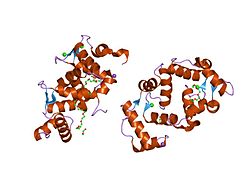Neuronal calcium sensor-1 (NCS-1) also known as frequenin homolog (Drosophila) (freq) is a protein that is encoded by the FREQ gene in humans. NCS-1 is a member of the neuronal calcium sensor family, a class of EF hand containing calcium-myristoyl-switch proteins.
Function
NCS-1 regulates synaptic transmission, helps control the dynamics of nerve terminal growth, is critical for some forms of learning and memory in C. elegans and mammals, regulates corticohippocampal plasticity; and enhancing levels of NCS-1 in the mouse dentate gyrus increases spontaneous exploration of safe environments, potentially linking NCS-1 to curiosity.
NCS-1 is a calcium sensor, not a calcium buffer (chelator); thus it is a high-affinity, low-capacity, calcium-binding protein.
Frq can substitute for calmodulin in some situations. It is thought to be associated with neuronal secretory vesicles and regulate neurosecretion.
- It is the Ca2+-sensing subunit of the yeast phosphatidylinositol (PtdIns)-4-OH kinase, PIK1
- It binds to many proteins, some in calcium dependent and some in calcium independent ways, and switches many of the targets "on" (some off).
-
Calcineurin (protein phosphatase 2B)
-
GRK2 (G-protein-coupled receptor kinase 2)
- D2 dopamine receptor
-
IL1RAPL1 (interleukin-1 receptor accessory protein-like 1 protein)
- PI4KIIIβ (type III phosphatidylinositol 4-kinase β)
-
IP3 receptor (this activity is inhibited by lithium - a drug used for the treatment of bipolar disorder)
- 3',5'-cyclic nucleotide phosphodiesterases
-
ARF1 (ADP Ribosylation factor 1)
- A type (Kv4.3; Shal-related subfamily, member 3) voltage-gated potassium channels
- Nitric oxide synthase
-
TRPC5 channel
- Ric8a
- Frq modulates Ca2+ entry through a functional interaction with the α1 voltage-gated Ca2+-channel subunit.
Structure
NCS-1 is a globular protein consisting of ten alpha-helices. Four pairs of alpha-helices each form independent 12-amino-acid loops containing a negatively charged calcium binding domain known as an EF-hand. However, only three of these EF hands are functional (the most N-terminal EF-hand does not bind calcium). They could be occupied not only by calcium but also by magnesium and zinc ions. NCS-1 also contains at least two known protein binding domains, and a large surface exposed hydrophobic crevice containing EF-hands three and four. There is a myristoylation motif at the N-terminus that presumably allows NCS-1 to associate with lipid membranes.
Clinical significance
The expression of NCS-1 increases in bipolar disorder and some forms of schizophrenia and decreases in inflammatory bowel disease. NCS-1 has also been linked with Autism. In addition NCS-1 is significant in intelligence in creating curiosity by its function on dopamine D2 receptors in the dentate gyrus, increasing memory for complex tasks. http://www.physorg.com/news172174436.html
History
NCS-1 was originally discovered in Drosophila as a gain-of-function mutation associated with frequency-dependent increases in neurotransmission. A role in neurotransmission was later confirmed in Drosophila using frq null mutants. Work in bovine chromaffin cells demonstrated that NCS-1 is also a modulator of neurotransmission in mammals. The designation 'NCS-1' came from the assumption that the protein was expressed only in neuronal cell types, which is not the case.
Further reading
External links
|
PDB gallery
|
|---|
1g8i: CRYSTAL STRUCTURE OF HUMAN FREQUENIN (NEURONAL CALCIUM SENSOR 1)
|






